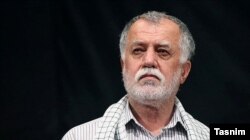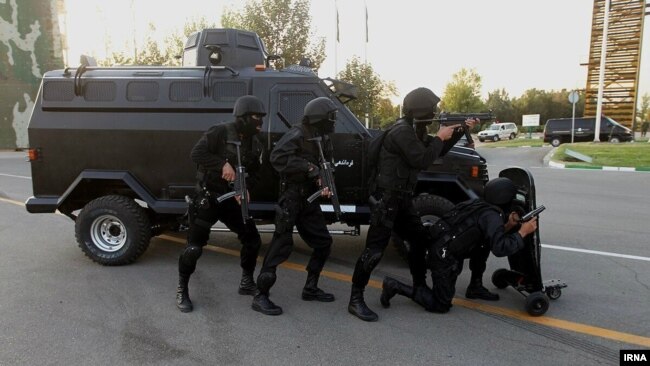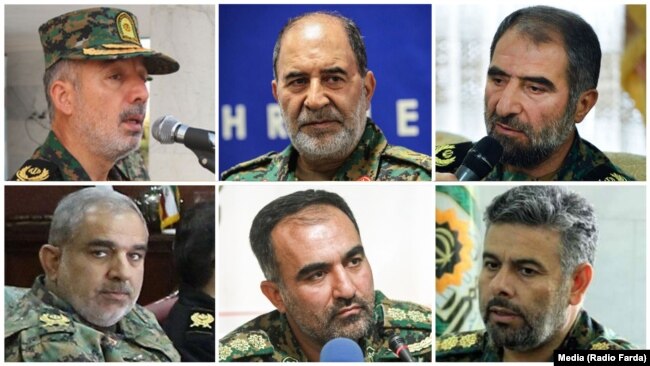Radiofarda – “Special Unit” is another name for suppression. The Islamic Republic’s supporters believe it is in charge of suppressing “riots”, while its critics know it as a force that harshly cracks down on popular anti-government protests.
The unit is as old as dissent in the Islamic Republic. The first urban upheaval against the Islamic Republic took place in Mashad in 1992, one year after the birth of the Special Unit. The unit was set up after the merger of various types of police forces. It soon became the most radical part of the Iranian security forces.
The new unit confronts the regime’s critics in the streets and follows a shoot to kill policy as its routine way of confronting dissent. Most of its personnel, including its founding commander Seyyed Mojtaba, came from the -now obsolete – Islamic Revolutionary Committee.

Seyyed Mojtaba Abdollahi was a man with an unusually thick moustache and an extremely thin and short beard many thought he did not have. He was one of the commanders of the eight-year-long with Iraq in the 1980s.
Then President Ali Khamenei met and befriended Seyyed Mojtaba in 1980s and commissioned him to set up and command the Special Unit which was to crush any uprising against the Islamic Republic. Mojtaba kept that job for 21 years before finally he left the unit in 2012 to become a senior adviser to the Iranian police chief.
In its first serious mission the Special Unit crushed the mutiny in Mashahd, two years later, it suppressed protesters in Qazvin near Tehran, and a year later a major protest movement by bus and truck drivers in Eslamshahr in the southern suburbs of Tehran.
Five years later in 1999 the largest ever street protests took place against the Islamic Republic by university students in Tehran. Led by Seyyed Mojtaba, Special Unit plainclothes militia stormed the Tehran University dormitory leaving hundreds of students badly wounded.

During the students’ protests in Tehran, for the first time since 1979, demonstrators chanted slogans against Khamenei, and called him a “criminal.” The first pictures of Iranian riot police, their motorcycles, shields and batons were published in 1999.
Two years later, the unit was called in to suppress another protest demonstration to mark the anniversary of the initial clashes between students and the special unit.
However, the most eye-catching presence of the Special Unit took place during the protests that followed the disputed Presidential election in 2009 which brought ultraconservative President Mahmoud Ahmadinejad to power. That was by far the biggest crack down on protests in Iran until then. Other forces were also called in to help with the bloodiest suppression of dissent in Iran before 2019.
During massive nationwide protest that rocked Iran in December 2017 and January 2018, the Special Unit was called in once again. Although tens of demonstrators were killed during those protests, they were still nothing to be compared with what happened during November 2019 both in terms of the number of protesters and the heavy suppression that claimed hundreds of lives.

According to Hassan Karami who has been the commander of the Special Unit since 2012, the unit does not have combat weapons. He said his men are armed only with pinball guns. Yet the deadliest suppression of all times in Iran took place when the Special Unit confronted protesters in the streets of Iranian cities and small towns between November 15 to 18 when the Special Unit was the main security force on the ground next to plainclothes militia.
Around 1,500 protesters were shot to death during those days according a recent special report by Reuters.
The number of Special Unit troops has never been announced. However, at least 20,000 of them were assigned to secure the Arba’in ceremony earlier this year according to Karami.
The Special Unit operates under the Police force within separate national and provincial structures. The Unit has four brigades stationed in Tehran and in the city’s suburbs. These are: Brigade 1 Amir ol-Momenin, Brigade 2 Mua bin Jafar, Brigade 3 Imam Hussain, and Brigade 4 Imam Khomeyni. The reason why the Special Unit is mainly based in and around Tehran is that it is the most volatile and dangerous area in Iran in terms of anti-government protests that can threaten the seat of the regime.
The Special Unit also maintains forces in all the 31 provinces of Iran. During the past three years the Special Unit has not had a chance to leave the streets of Iran as anti-government protests have continued almost all over the country. With Such a structure, experience and operational background, the Special Unit is the Islamic Republic’s mightiest suppression machine.
- Morad VeisiMorad Veisi is a journalist and an editor at Radio Farda and is considered an expert in affairs related to Iran’s IRGC and the Supreme Leader ayatollah Ali Khamenei.
 Shabtabnews In this dark night, I have lost my way – Arise from a corner, oh you the star of guidance.
Shabtabnews In this dark night, I have lost my way – Arise from a corner, oh you the star of guidance.


